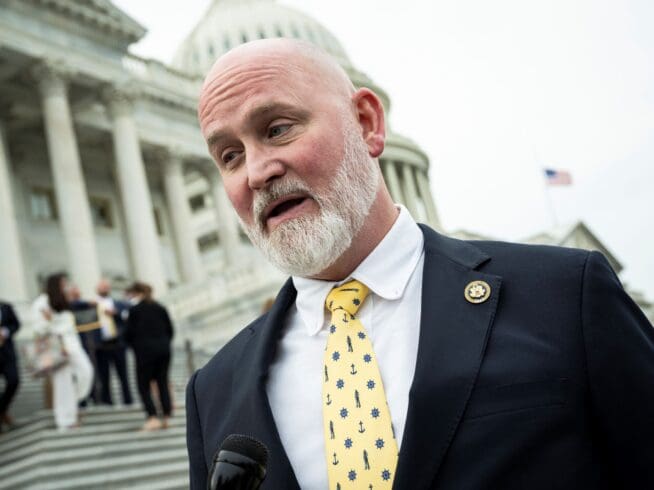Wisconsin will soon have new legislative maps. Will they shift the balance of power?
Seven proposals have been submitted to the Wisconsin Supreme Court, which plans to implement a new map before the November 2024 elections.

There are a lot of uncertainties surrounding Wisconsin’s elections this November: As the state’s legislative maps are being redrawn, voters may see new candidates on their ballots or they may find themselves in entirely new districts.
It’s almost certain, however, that there will be a shift in power. Exactly how big a shift is yet to be determined.
During redrawing of legislative maps — a process known as redistricting — the boundaries of legislative districts are reconfigured to adjust for population changes. So a voter who lives at the edge of Senate District 32 in western Wisconsin, for example, may get bumped into Senate District 31, depending on how the new boundaries of the districts are redrawn. This happens every decade following the census, but in this case, the Wisconsin Supreme Court threw out the maps drawn after the census and ordered them to be redrawn.
Seven map proposals were submitted to the court last week, and most of them weaken Republicans’ majorities in the state Legislature. Some of the proposed maps weaken it more than others, and few of them eliminate a GOP majority entirely.
The Supreme Court ordered new maps last month after ruling in Clarke et al. v. Wisconsin Elections Commission et al. that the current legislative maps were unconstitutional because many of the districts contain detached land, creating a Swiss cheese effect. Wisconsin has long been considered one of the most gerrymandered states in the country, with maps that have been drawn to favor Republicans for more than a decade.
Even though Wisconsin is a purple state that tends to vote evenly in statewide elections — the state voted for former Democratic presidential candidate Barack Obama in 2012, for Republican Donald Trump in 2016, and then for Democrat Joe Biden in 2020, for example — Republicans hold majorities in both the State Assembly and the State Senate.
Those majorities have grown over the last decade. In the Senate, Republicans hold 21 of the 33 seats, giving them a supermajority. In the Assembly, Republicans are just a few seats short of holding a supermajority, holding seats in 64 of the 99 districts. If Republicans were to claim a supermajority in both chambers, it would give them the power to override Democratic Gov. Tony Evers’ vetoes.
The drawing of new maps is intended to disrupt the current gerrymandered maps by making the partisan split more accurately reflect that of the electorate. The seven remedial maps submitted to the court for consideration came from the Democratic voters who brought the lawsuit in Clarke and the liberal law firm that represented them, Law Forward; Republican legislative leaders; Gov. Evers; Democrats in the State Senate; University of Wisconsin–Milwaukee professors who have created their own redistricting algorithm called FastMap; and the conservative law firm Wisconsin Institute for Law and Liberty, also known as WILL.
The maps only redraw Wisconsin’s state legislative districts, not its U.S. House districts. However, a new lawsuit filed this week by the Democratic law firm Elias Law Group challenges the state’s congressional maps. The plaintiffs argue that the congressional maps are unconstitutional because they were redrawn to create the least amount of change to the previous maps, criteria that the Supreme Court threw out when it overturned the legislative maps in December.
What do the new maps look like?
The court has required the new state legislative maps to be drawn with several stipulations: The districts must be contiguous, as compact as possible, equally populated, and shouldn’t split boundaries of counties, precincts, wards or towns. The maps should also consider partisan impacts and communities of interest and should avoid splitting municipalities.
The maps submitted by WILL and Republican legislative leaders make the smallest reductions to Republicans’ majority, according to an analysis from Marquette University Law School researcher John Johnson. Republican state legislators’ map would create 35 Democratic seats in the state Assembly and 64 Republican seats. WILL’s map would create 39 Democratic seats and 60 Republican seats.
On the flip side, the map submitted by Law Forward and the lawsuit plaintiffs favor Democrats the most. It would create 49 Democratic seats and 50 Republican seats, Johnson found.
The changes in the State Senate would be relatively the same, Johnson said, though the plan submitted by Democratic senators and the plan from UW–Milwaukee professors would create a Democratic majority in the Senate. Only half of State Senate seats are reelected at a time, and this year, the seats in even-numbered districts will be up for reelection.
Johnson told Wisconsin Public Radio that there isn’t an outright winner among the maps that fits the court’s requirements the best. Because of this, the court will likely have to decide which criteria are most important to them when deciding on a map.
Regardless, Wisconsin is “going to have a different electorate,” Johnson told WPR.
The maps will now be reviewed by political scientists Bernard Grofman of the University of California–Irvine and Jonathon Cervas of Carnegie Mellon University, who were hired as consultants by the court. Their analysis is due by Feb. 1.
The Republican-controlled State Legislature and Evers have the chance to choose a map on their own. But if they can’t agree on one, the court will decide.
New maps must be approved and in place by March 15 to make sure they can be implemented before the August primary ahead of the November general election.
Republican leaders have threatened to appeal to the U.S. Supreme Court, though Assembly Speaker Robin Vos said he didn’t want to rush to that. “We are ready, willing and able to try to engage” in solving the map issue through the Legislature, he said at a news conference on Jan. 16.
Editor’s note: Elias Law Group has been affiliated with the American Independent.




